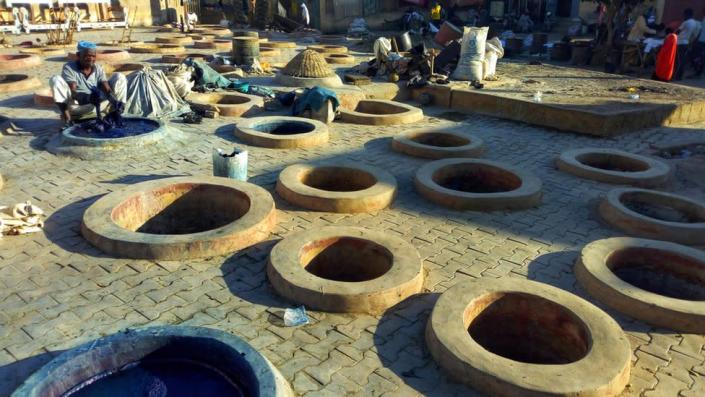
For more than six centuries, a vast area of land in the historic city of Kano in northern Nigeria has been home to dye pits, where beautiful fabrics are produced using ancient techniques.
The materials – dyed a signature deep blue colour – have long been sold across Africa and the Middle East.
But many worry the industry is now at risk.
“The young generation do not want to join the dyeing folks,” complains Baba Muhammad as he squats near a wide pit, filled with a murky, indigo coloured liquid.
The 75-year-old dips a piece of cloth into the hole, his hands covered with rubber gloves.
The veteran dyer worries that he may be one of the last people to perform the ancient ritual as young people have more modern tastes.
“They prefer to go into business; they like to design the fabrics, but not dyeing them.”
‘Blue men of the desert’
The Kofar Mata dye pits – established at the turn of the 16th Century – were once a source of livelihood for thousands of local people.
The unique designs of the fabrics are usually created by women, who twist and tie the material in their homes into different shapes to produce the patterns. The tied fabrics are then handed over to the dyers.


Kano city is an important economic hub for northern Nigeria and was a crucial part of trans-Saharan trade in pre-colonial times.
Historians talk of how Tuaregs – the so-called “blue men of the desert” – named after the striking colour of their clothes – used to visit the ancient city.
There they traded camels and dates to get their hands on the vibrantly dyed fabrics.
The appeal of Kofar Mata fabrics was largely down to the locally sourced and natural ingredients used to dye the clothes.
To this day, dyers say that they avoid artificial ingredients, and instead rely on things like the local indigo plant, which gives the material its colour.
Insecurity threatens trade
But in recent years, this ancient tradition has been battling a myriad of threats.
One is the Boko Haram insurgency, which has meant that customers are scarce – especially those travelling through the north-east of Nigeria where the Islamist militants are active. It has also had an impact on those coming from further afield.


“Tourists used to come here all the time from all over the world: France, Germany, the UK and America – but the problem of insecurity in northern Nigeria has affected this business,” Baballiya Hamisu, another dyer, says.
At 37 years old, Mr Hamisu is one of the youngest dyers working at the pits.
“I started dying when I was about 10 years old, so I’ve been doing it for about 25 years,” he said.
Still, Mr Hamisu says he is old enough to be nostalgic about the vanishing art form.
“When I was a child, the dye pits here were countless, but now we only have 144, of which not more than 15 are in use.”
Hunger for land
Kano is among the fastest-growing cities in sub-Saharan Africa. It has witnessed highly controversial demolitions of a number of its historical sites in recent years, which the government has said is necessary to ensure its transformation into a modern city.


Tijjani Muhammad Naniya, a historian at Kano’s Bayero University, says urbanisation is not the only thing threatening the dyeing pits.
“The problem started from a colonial policy to transform Kano’s economy, which saw the city importing clothes from Manchester and other places abroad,” he explained.
The rise in cheap foreign fabrics is a major issue for local dyers.
They say that although prices are relatively similar, competition is stiff, with many customers attracted to the new and flashy modern designs.


Most of the men working at the pits are descendants dyers, like Haruna Baffa, the secretary of the Kofar Mata Dye Pits, who says he is seventh generation.
With a smiling face, he traces his family’s rich history: “I inherited this business from my father; my father inherited it from his father – it’s generation to generation.
“My seventh great grand-father, Muhammadu Dabosa, is the founder of the dye pit centre.”
The dyers say they are receiving no formal help from local or regional governments.
Mr Hamisu insists that more could be done to preserve the historically significant industry.
“If the government can buy our products and encourage people to do the same we will thrive,” he said.
“Imagine the president or a governor wearing one of our Kofar Mata fabrics, no matter how worthless it seems to be, it’ll become valuable.”
More on Africa and fabrics:




